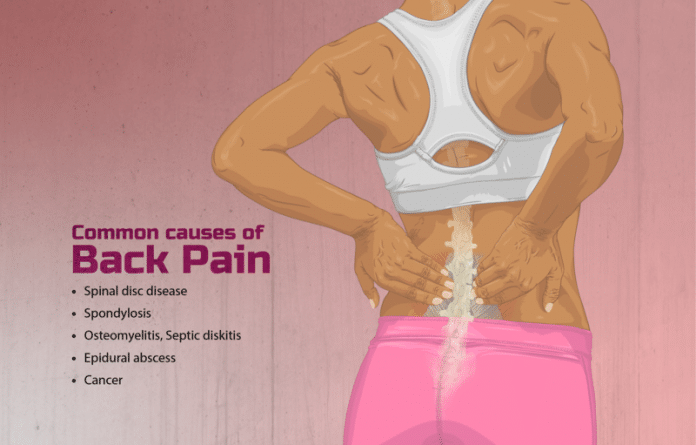What is back pain?
Back pain can refer to discomfort or sometimes debilitating risk posed by a back injury or other ailments. It is a common health condition and a leading cause of disability around the world. Spinal pain affects around 16 million adults per year, with the lower back being the most prevalent place. The structures of your spine age along as you become older or cause instilled abnormality of the back.
Causes and symptoms
Here are a few underlying conditions that may cause back pain:
1. Sprain and strain
The back sprains and strains can result from overuse, sports injuries, twisting awkwardly, or lifting something too heavy or improperly. Excessive activities can also lead to stretching of back muscles and ligaments.
The prominent symptoms can comprise of:
- Pain and stiffness in the lower back
- Back muscle spasms
- Swelling and tenderness
2. Fracture in any part of the vertebral column or a ruptured disc
The discs in the backbone are vulnerable and prone to injuries. A forceful impact to the back can cause vertebral fractures and herniated or ruptured discs, as well as other spinal injuries. This risk tends to increase with maturity, as its surrounding can tear or herniate.
Possible reasons for this condition include:
- Fall from height
- Motor vehicle accidents
- Sports injuries
This type of back pain usually occurs almost immediately after the injury. Further symptoms may include tingling and numbness that radiates down the legs.
3. Cauda equina syndrome
It is a rare disorder that occurs when a bundle of nerves in the lumbar section compress. Cauda equina syndrome is a medical emergency that can give rise to critical complications if not treated promptly.
Apart from severe lower back pain being a primary indication, the symptoms of cauda equina syndrome often include:
- Bowel and bladder problem
- Numbness, weakness, or loss of sensation in one or both legs
- Difficulty walking and standing up
4. Tumors and infections
Infections of pathogenic bacteria, viruses, or fungus can develop in the spine and adjacent tissues. Tumors may also grow out as a consequence of diseases like diabetes, cancer, or HIV.
A spinal infection can induce the following symptoms:
- Muscle spasms
- Edema, redness, and soreness
- Loss of sensation in the legs
- Chills and fever
5. Degenerative disc disease
The discs present in the vertebral column serve as protective cushions. When these discs start to wear out, the vertebra may begin to rub one against another, causing back pain.
Bending, twisting, and lifting may aggravate the discomfort but improve with walking or moving.
6. Spinal stenosis
The narrowing of the spinal canal exerts pressure and strain on the spine along with the nerve roots that trigger spinal stenosis. People over the age of 50 are more likely to have this condition.
The common symptoms consist of:
- Sciatica
- Numbness and weakness in one or both legs
- Cramps in the affected region of the backbone
- Difficulty in walking and standing up
7. Spinal scoliosis
It is an abnormality of the curvature of the spine that typically leads to irregular shoulders and hips joints. Usually, it is a hereditary condition recognized during childhood, just before they have a growth spurt. The sideway misalignment of the spine causes pain and poor posture, resulting in extreme pressure on the vertebra. Scoliosis can develop at any age. However, children with scoliosis are more prone to have lower back pain than adults.
6. Car accidents
The cause of car accidents that result in spinal injuries is at a peak in the United States. The accident clinics in Atlanta provide highly skilled orthopedists for car accident injury treatment.
Some other possible complications that cause back pain can include:
- Endometriosis
- Osteoporosis
- Arthritis of the spine
- Kidney stones
- Pregnancy
- Cancer
- Uterine fibroids
Seeking immediate medical attention if you experience any of these symptoms in addition to low back pain will be the right thing to do.
Treatment options
The various treatment options depend on the type and severity of the injury.
1. Self-care
If the pain does not improve after 72 hours of using self-care techniques, you should see a back pain doctor.
- Practicing a good posture helps ease the pressure on your lower back.
- Certain back accessories, such as straps or flexible bands, can assist in keeping your backbone upright. If a child has scoliosis, wearing a special back brace while their growth is effective to prevent additional curvature of the spine.
- To keep your back working and intact, continue your activities as much as you can tolerate and avoid activities that increase pain.
- Exercising regularly and maintaining a healthy weight can help reduce the risk of severe back pain.
- Quit smoking as it is harmful to an individual’s overall health.
- You can often relieve back sprains and strains at home with rest, ice packs, and gentle stretching.
2. Physical therapy and rehabilitation
Seeking physical therapy is the best alternative if you don’t want to worsen your injury. Stretching gently and engaging in limited activities like walking might help keep the back muscles from becoming overly tense. It lowers a patient’s chances of becoming paralyzed permanently. Rehabilitation psychologists may recommend meditation, yoga, and other cognitive strategies for relaxation.
3. Medication
Depending on the type of back pain you have, your doctor might prescribe the following:
- (OTC) pain relievers
- Creams and ointments
- Antidepressants
- Antibiotic or antifungal medications
Some antidepressants relieve chronic back pain being independent of their effect on depression, particularly tricyclic antidepressants.
4. Healthy diet and lifestyle modifications
Regular exercise and a nutritious diet go a long way in keeping our bones and the rest of our bodies healthy. It is critical to have the proper nourishment in your diet to ensure strong bones and joints.
Here are some of the ideal foods to include in your diet daily to make sure that your body receives all of the vitamins it requires to keep your bones healthy and intact:
- Fish
- Dairy products that are low in fat (low-fat dairy products)
- Soy food
- Olive oil
- Cherries
- Green vegetables
Calcium is one of the most vital minerals for strong bones. Green leafy vegetables such as kale, spinach, Chinese cabbage, and broccoli possess calcium in large quantities. Besides containing a high amount of vitamins C and K, broccoli also contains the compound sulforaphane, which helps slow down the progression of wearing bones.
- Sweet potatoes
- Grapefruit
- Green tea
Furthermore, a controlled lifestyle not only helps your back feel better but could also prevent your condition from advancing.
5. Surgical methods
For extended back pain, the doctor will generally recommend surgery to relieve pressure on the nerves. Surgeries help in curing severe infections by draining the infected area. A surgeon may perform the most suitable surgery; spinal fusion for children or adults with severe scoliosis.
6. Injections
Epidural steroid injections and other injection-based procedures are available for chronic back pain when other methods go unsuccessful.
Suitable doctors to visit
Sudden or severe pain in the back should get checked by a back pain doctor or a physical therapist. Atlanta provides sufficient doctors for a carefree treatment.
1. Primary care providers are often the first port of call for patients when back pain strikes. They can help you identify the reasons for your discomfort and recommend the best treatment for you.
These include:
- Primary care physicians
- Chiropractors
- Doctors of Osteopathic Medicine
2. Therapists specialize in either physical or occupational rehabilitation for back pain or psychological help for chronic pain, and generally include:
- Physical therapists
- Occupational therapists
- Clinical psychologists
3. Spine specialists have a more specific area of expertise in certain prognoses and cures for back pain and spinal conditions and include:
- Surgeons
- Orthopedics
- Neurologists
- Rheumatologists
Last Words
There are many types of health practitioners that care for patients with spinal conditions. The selection of the most appropriate health professionals or team of health professionals largely depends on your symptoms and their prevailing time.





